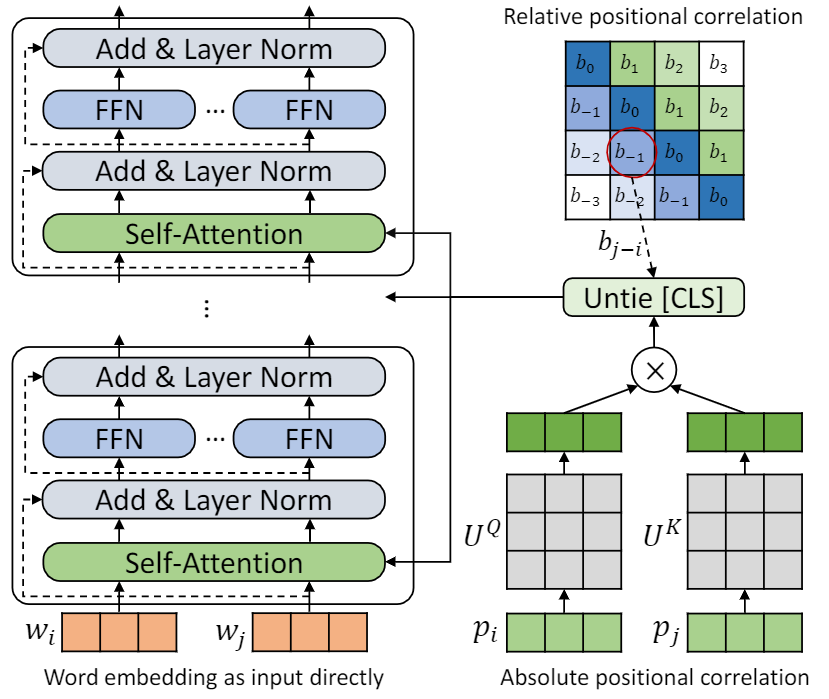guolinke / Tupe
Programming Languages
Projects that are alternatives of or similar to Tupe
TUPE (Transformer with Untied Positional Encoding)
Implementation for the paper Rethinking Positional Encoding in Language Pre-training.
Brief Introduction
This repo is to demonstrate TUPE (Transformer with Untied Positional Encoding). The algorithm details could be found in our paper. TUPE can outperform other baselines on GLUE benchmark by a large margin. In particular, it can achieve a higher score than baselines while only using 30% pre-training computational costs.
Due to limited computational resources, we use the most widely-used pre-training model, BERT-Base, for verification. However, please note that our method could be used for larger (and better) Transformer-based models, like RoBERTa, ELECTRA and UniLM, and further improve them. Besides, since the modification is simple and easy, you can easily apply TUPE in your models.
Our implementation is based on fairseq, with several changes:
- update
fairseq/modules/transformer_sentence_encoder.pyandfairseq/modules/multihead_attention.pyfor untied positional encoding. - some other minor changes to support
max-epochwithwarmup-ratioin finetune, instead of setting differenttotal-num-updateandwarmup-updatesfor different tasks.
Requirements and Installation
More details see fairseq. Briefly,
- PyTorch
- Python version >= 3.5
- NVIDIA's apex library with the
--cuda_extinstallation option, for mixed precision training - You may need NCCL for multi-node distributed training
Installing from source
To install TUPE from source and develop locally:
git clone https://github.com/guolinke/TUPE
cd TUPE
pip install --editable .
Getting Started
Data Pre-Processing
The pre-processing relies on mosesdecoder, you can run the following script to pull it.
cd TUPE
git submodule update --init
Pretraining Data
Refer to the steps in preprocess/pretrain/process.sh.
Downstream Data
Refer to the steps in preprocess/glue/process.sh.
Pre-Training
DATA_DIR=./path_to_your_data/
SAVE_DIR=./your_own_save_path/
TOTAL_UPDATES=1000000
WARMUP_UPDATES=10000
PEAK_LR=0.0001
MAX_POSITIONS=512
MAX_SENTENCES=16
UPDATE_FREQ=1
SEED=your_seed
python train.py $DATA_DIR --fp16 --num-workers 16 --ddp-backend=c10d \
--task masked_lm --criterion masked_lm --arch bert_base \
--sample-break-mode complete --tokens-per-sample $MAX_POSITIONS \
--optimizer adam --adam-betas '(0.9, 0.999)' --adam-eps 1e-6 --clip-norm 1.0 \
--lr-scheduler polynomial_decay --lr $PEAK_LR --warmup-updates $WARMUP_UPDATES --total-num-update $TOTAL_UPDATES \
--dropout 0.1 --attention-dropout 0.1 --weight-decay 0.01 \
--max-sentences $MAX_SENTENCES --update-freq $UPDATE_FREQ --seed $SEED \
--mask-prob 0.15 \
--embedding-normalize \
--max-update $TOTAL_UPDATES --log-format simple --log-interval 100 \
--keep-updates-list 100000 300000 600000 1000000 \
--save-interval-updates 25000 --keep-interval-updates 3 --no-epoch-checkpoints --skip-invalid-size-inputs-valid-test \
--save-dir $SAVE_DIR --rel-pos
The above setting is for 16 V100 GPUs, and the batch size is 256 (n_gpu * MAX_SENTENCES * UPDATE_FREQ). You may need to change MAX_SENTENCES or UPDATE_FREQ according to your environment. To disable relative position, you can remove --rel-pos .
Fine-Tuning
DATA_DIR=./path_to_your_downstream_data
SAVE_DIR=./path_to_your_save_dir
BERT_MODEL_PATH=./path_to_your_checkpoint
BATCH_SIZE=32
N_EPOCH=10 # 5 for MNLI, QNLI, QQP
SEED=your_seed
WARMUP_RATIO=0.06
N_CLASSES=2 # 3 for MNLI, 1 for STS-B
LR=0.00005 # search from 2e-5, 3e-5, 4e-5, 5e-5
METRIC=accuracy # mcc for CoLA, pearson for STS-B
python train.py $DATA_DIR --fp16 --fp16-init-scale 4 --threshold-loss-scale 1 --fp16-scale-window 128 \
--restore-file $BERT_MODEL_PATH \
--max-positions 512 \
--max-sentences $BATCH_SIZE \
--max-tokens 4400 \
--task sentence_prediction \
--reset-optimizer --reset-dataloader --reset-meters \
--required-batch-size-multiple 1 \
--init-token 0 --separator-token 2 \
--arch bert_base \
--criterion sentence_prediction \
--num-classes $N_CLASSES \
--dropout 0.1 --attention-dropout 0.1 \
--weight-decay 0.01 --optimizer adam --adam-betas '(0.9, 0.999)' --adam-eps 1e-06 \
--clip-norm 1.0 --validate-interval-updates 2 \
--lr-scheduler polynomial_decay --lr $LR --warmup-ratio $WARMUP_RATIO \
--max-epoch $N_EPOCH --seed $SEED --save-dir $SAVE_DIR --no-progress-bar --log-interval 100 --no-epoch-checkpoints --no-last-checkpoints --no-best-checkpoints \
--find-unused-parameters --skip-invalid-size-inputs-valid-test --truncate-sequence --embedding-normalize \
--tensorboard-logdir . \
--best-checkpoint-metric $METRIC --maximize-best-checkpoint-metric --rel-pos
To speed up finetune, we set N_EPOCH=5 for MNLI, QNLI and QQP, and N_EPOCH=10 for others. For MNLI, N_CLASSES=3 and an additional setting --valid-subset valid,valid1 is used for evaluating MNLI-m/-mm together. STS-B is a regression task, so we set N_CLASSES=1, with additional settings --regression-target and METRIC=pearson. For CoLA, we set METRIC=mcc.
LR is searched from {2e-5, 3e-5, 4e-5, 5e-5}, each LR will be run by 5 different seeds, and we use the median of them as the result of that LR. The result of the best LR will be used.
NOTE: If your pretraining model used --rel-pos, you should set --rel-pos in the finetune, otherwise you should remove it.
We also release the checkpoint of TUPE-R (with --rel-pos), for reproducibility.
Reference
You can cite our paper by
@inproceedings{
ke2021rethinking,
title={Rethinking Positional Encoding in Language Pre-training},
author={Guolin Ke and Di He and Tie-Yan Liu},
booktitle={International Conference on Learning Representations},
year={2021},
url={https://openreview.net/forum?id=09-528y2Fgf}
}


